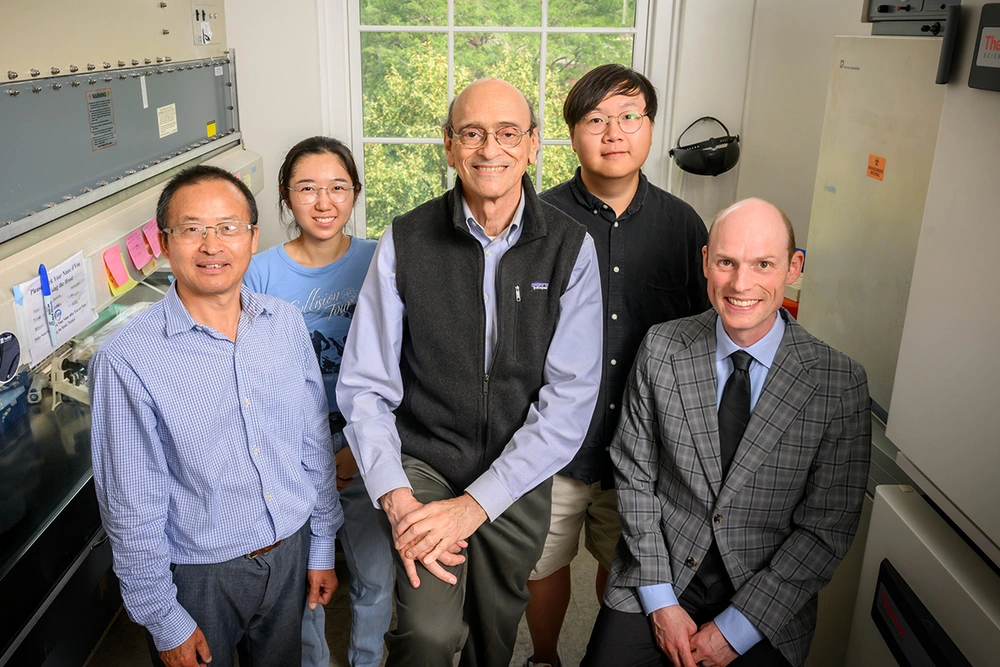
A team of scientists, including several from the School of Molecular & Cellular Biology, have identified a protein that plays a pivotal role in the action of several emerging cancer therapies. The researchers say the discovery will likely aid efforts to fine-tune the use of immunotherapies against several challenging cancers. They report their findings in the journal Cancer Research.
“Most anticancer drugs cause cancer cells to shrivel up and die in a controlled process known as apoptosis. But apoptosis does not usually strongly activate immune cells,” said David Shapiro, a professor of biochemistry at the University of Illinois Urbana-Champaign who led the research with former graduate student Santanu Ghosh. “However, a few emerging cancer therapies cause cancer cells to swell up and burst. The protein we identified, a sodium-ion channel known as TRPM4, is critical for cancer therapies that promote this type of cell death, called necrosis.”
Unlike apoptosis, necrosis strongly signals the immune system to target and cleanup the remains of the dying cells, Shapiro said. “This suggests that treatments that promote necrosis may improve immunotherapies against solid tumors,” he said.
TRPM4 is the first protein mediator of anticancer therapy-induced necrosis to be described, Shapiro said.
In previous work, Shapiro, U. of I. chemistry professor and study co-author Paul Hergenrother and their colleagues developed two drugs – a compound called BHPI and later, a more effective agent known as ErSO – that spur necrosis in solid tumors, dramatically shrinking and often eradicating primary and metastatic tumors in mice. These drugs work by binding to estrogen receptors on cancer cells and pushing a normally protective cellular stress-response pathway into overdrive. This pathway, the “anticipatory unfolded protein response, or a-UPR,” ultimately causes the cell to swell, leak and die.
“Even though we identified the initial steps in the a-UPR pathway that kills cancer cells, the specific proteins that mediate cell swelling, rupture, and rapid necrotic cell death remained unknown,” Shapiro said.
To identify the relevant proteins, Shapiro and his colleagues screened breast cancer cells by knocking out each of the roughly 20,000 individual genes in the cancer cells and then treating the altered cells with BHPI or ErSO. Cells that resisted treatments with these agents revealed which genes were essential to the drugs’ effectiveness.
The researchers were surprised to find that TRPM4 emerged as a key driver of the process of necrosis in cancer cells treated with ErSO and BHPI. The team also found that TRPM4 was important for the activity of several other necrosis-inducing cancer therapies.
“This will enable physicians to identify patients most likely to benefit from necrosis-inducing therapies because their cancers have high TRPM4 levels,” Shapiro said.
Further study revealed that an ErSO-induced increase in intracellular calcium causes the TRPM4 channel to open, allowing sodium ions and water to flow into the cell. The influx causes the cell to swell, rupture and leak, activating immune cells and causing them to rush to the site of the dead cells.
“Cancer treatment has been transformed by immunotherapy, which takes the brakes off immune cells, enabling them to attack cancer cells,” Shapiro said. “But immunotherapy has had limited success against solid tumors such as ER-positive breast cancer and pancreatic cancer.”
By targeting the TRPM4 pathway in solid tumors, scientists may further enhance the necrosis-inducing anticancer therapies available to fight such tumors, he said.

“We found that the cancer drug ErSO acts like the starter on a car that turns over the engine and then is no longer needed once the engine is running,” Ghosh said. “It is the swelling caused by TRPM4 that drives the lethal stress that kills the cancer cells. As little as a one-hour exposure to ErSO effectively killed cancer cells days later.”
The National Institutes of Health, the Cancer Center at Illinois, the Department of Defense Breast Cancer Research Program, the Susan Komen Foundation, and the Breast Cancer Research Foundation supported this research.
Hergenrother is the deputy director and Shapiro is a researcher in the Cancer Center at Illinois. Hergenrother also is an affiliate of the Carl R. Woese Institute for Genomic Biology and the Carle Illinois College of Medicine at Illinois. Ghosh (PhD, biochemistry, 2022) is now a postdoctoral researcher at the University of Pennsylvania Perelman School of Medicine.
Co-authors of the study also include undergraduate student Rachel Yang, graduate students Darjan Duraki, Junyao Zhu, Ji Eun Kim, Musarrat Jabeen, Xinyi Dai, Mara Livezey, and Matthew Boudreau; research scientist Chengjian Mao; U. of I. molecular and integrative physiology professor Erik Nelson; and professor Ben Park, of Vanderbilt University College of Medicine.
Editor’s note:
To reach David Shapiro, email djshapir@illinois.edu
The paper “Plasma membrane channel TRPM4 mediates immunogenic therapy-induced necrosis” is available to members of the media from the U. of I. News Bureau.

